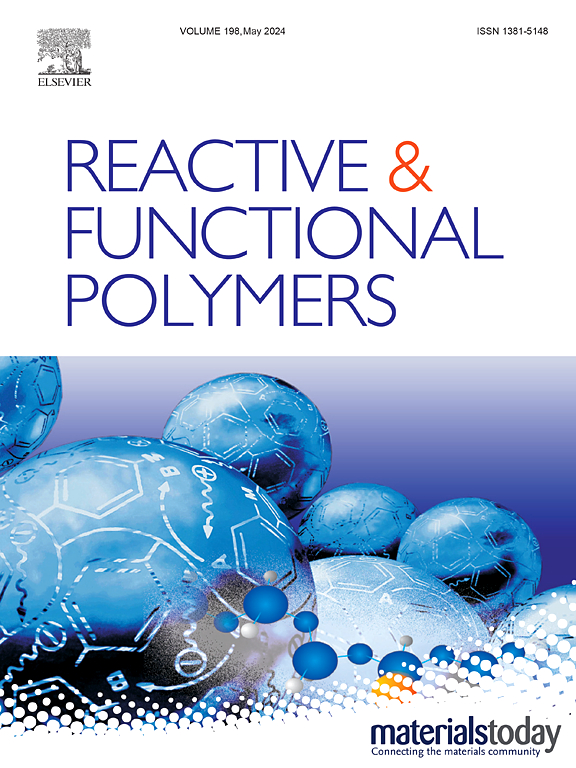Redox/pH dual-responsive sodium alginate/cassava starch composite hydrogel beads for slow release of insecticides
IF 5.1
3区 工程技术
Q1 CHEMISTRY, APPLIED
引用次数: 0
Abstract
Insecticides play a crucial role in promoting crop growth and boosting crop yields. However, they also contribute to environmental pollution and pose risk to human health. To increase the utilization rate of insecticides and minimize their pollution of the soil and water environment, it is imperative to develop a green material or carrier for the controlled-release of agrochemicals including insecticides. In this study, composite hydrogel beads were successfully prepared using dialdehyde starch and sodium alginate as green-based raw materials, cystamine dihydrochloride as a cross-linking agent, and meanwhile sodium alginate was ionic cross-linked with calcium ions. As-prepared composite hydrogel beads possess pH/redox dual-responsive properties, enabling the controlled release of the insecticide dinotefuran (DIN). The properties, structure and morphology of the hydrogel beads were comprehensively characterized using Fourier transform infrared spectroscopy (FTIR), scanning electron microscopy (SEM), thermogravimetric analysis (TGA), and X-ray diffraction (XRD). Additionally, the release behavior of DIN from the composite hydrogel beads under various conditions was extensively investigated. The results showed that the incorporation of dialdehyde starch significantly enhanced the encapsulation efficiency of DIN within the hydrogel bead. Moreover, the cumulative release of DIN can be precisely modulated by adjusting the release conditions or environmental stimuli; the release kinetics align with the Korsmeyer-Peppas model well. Specially, DIN release is accelerated under neutral conditions and in the presence of the reducing agent glutathione (GSH). The findings of this work are anticipated to exert a positive influence on agricultural production while also contributing to the alleviation of insecticide-related adverse environmental impacts.

氧化还原/pH双响应海藻酸钠/木薯淀粉复合水凝胶微球缓释杀虫剂
杀虫剂在促进作物生长和提高作物产量方面起着至关重要的作用。然而,它们也造成环境污染,对人类健康构成威胁。为了提高杀虫剂的利用率,减少其对土壤和水环境的污染,开发包括杀虫剂在内的农用化学品的绿色控释材料或载体势在必行。本研究以双醛淀粉和海藻酸钠为绿色原料,以盐酸半胺为交联剂,海藻酸钠与钙离子进行离子交联,成功制备了复合水凝胶珠。制备的复合水凝胶珠具有pH/氧化还原双响应特性,能够控制杀虫剂呋喃(dinotefuran, DIN)的释放。利用傅里叶变换红外光谱(FTIR)、扫描电镜(SEM)、热重分析(TGA)和x射线衍射(XRD)对水凝胶珠的性质、结构和形貌进行了全面表征。此外,还广泛研究了不同条件下复合水凝胶珠中DIN的释放行为。结果表明,双醛淀粉的掺入显著提高了DIN在水凝胶珠内的包封效率。此外,可以通过调节释放条件或环境刺激来精确调节DIN的累积释放;释放动力学符合Korsmeyer-Peppas模型。特别是,在中性条件下和还原剂谷胱甘肽(GSH)的存在下,DIN释放加速。预计这项工作的结果将对农业生产产生积极影响,同时也有助于减轻与杀虫剂有关的不利环境影响。
本文章由计算机程序翻译,如有差异,请以英文原文为准。
求助全文
约1分钟内获得全文
求助全文
来源期刊

Reactive & Functional Polymers
工程技术-高分子科学
CiteScore
8.90
自引率
5.90%
发文量
259
审稿时长
27 days
期刊介绍:
Reactive & Functional Polymers provides a forum to disseminate original ideas, concepts and developments in the science and technology of polymers with functional groups, which impart specific chemical reactivity or physical, chemical, structural, biological, and pharmacological functionality. The scope covers organic polymers, acting for instance as reagents, catalysts, templates, ion-exchangers, selective sorbents, chelating or antimicrobial agents, drug carriers, sensors, membranes, and hydrogels. This also includes reactive cross-linkable prepolymers and high-performance thermosetting polymers, natural or degradable polymers, conducting polymers, and porous polymers.
Original research articles must contain thorough molecular and material characterization data on synthesis of the above polymers in combination with their applications. Applications include but are not limited to catalysis, water or effluent treatment, separations and recovery, electronics and information storage, energy conversion, encapsulation, or adhesion.
 求助内容:
求助内容: 应助结果提醒方式:
应助结果提醒方式:


